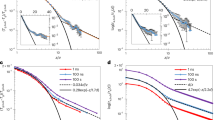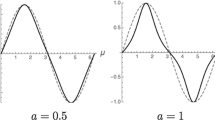Abstract
Liquid–vapour interfaces, particularly those involving water, are common in both natural and artificial environments. They were first described as regions of continuous variation of density1, caused by density fluctuations within the bulk phases2,3,4. In contrast, the more recent capillary-wave model5,6 assumes a step-like local density profile across the liquid–vapour interface, whose width is the result of the propagation of thermally excited capillary waves. The model has been validated for length scales of tenths of micrometres and larger7,8, but the structure of liquid surfaces on submicrometre length scales—where the capillary theory is expected to break down—remains poorly understood. Here we report grazing-incidence X-ray scattering experiments that allow for a complete determination of the free surface structure and surface energy for water and a range of organic liquids. We observe a large decrease of up to 75% in the surface energy of submicrometre waves that cannot be explained by capillary theory, but is in accord with the effects arising from the non-locality of attractive intermolecule interactions as predicted by a recent density functional theory9. Our data, and the results of comparable measurements on liquid solutions, metallic alloys, surfactants, lipids and wetting films should thus provide a stringent test for any new theories that attempt to describe the structure of liquid interfaces with nanometre-scale resolution.
This is a preview of subscription content, access via your institution
Access options
Subscribe to this journal
Receive 51 print issues and online access
$199.00 per year
only $3.90 per issue
Buy this article
- Purchase on Springer Link
- Instant access to full article PDF
Prices may be subject to local taxes which are calculated during checkout



Similar content being viewed by others
References
van der Waals, J. D. The thermodynamic theory of capillarity under the hypothesis of a continuous variation of density. Verh. Konink. Akad. Weten. Amsterdam (Sect. 1) 1 (1893). English translation by Rowlinson, J. S. J. Stat. Phys. 20, 197–244 (1979).
Rowlinson, J. S. & Widom, B. Molecular Theory of Capillarity Vol. 8 (International Series of Monographs on Chemistry, Oxford Univ. Press, 1982).
Cahn, J. W. & Hilliard, J. E. Free energy of a nonuniform system. i. Interfacial free energy. J. Chem. Phys. 28, 258–267 (1958).
Fisk, S. & Widom, B. Structure and free energy of the interface between fluid phases in equilibrium near the critical point. J. Chem. Phys. 50, 3219–3227 (1960).
Buff, F. P., Lovett, R. A. & Stillinger, R. H. Interfacial density profile for fluids in the critical region. Phys. Rev. Lett. 15, 621–623 (1965).
Gelfand, M. P. & Fisher, M. E. Finite-size effects in fluid interfaces. Physica A 166, 1–74 (1990).
Loudon, R. in Modern Problems in Condensed Matter Sciences (eds Agranovich, V. M. & Loudon, R.) Vol. 9, 589–638 (North-Holland Physics, Amsterdam, 1984).
Sanyal, M. K., Sinha, S. K., Huang, K. G. & Ocko, B. M. X-ray scattering study of capillary-wave fluctuations at a liquid surface. Phys. Rev. Lett. 66, 628–631 (1991).
Mecke, K. & Dietrich, S. Effective hamiltonian for liquid-vapor interfaces. Phys. Rev. E 59, 6766–6784 (1999).
Weeks, J. D. Structure and thermodynamics of the liquid-vapor interface. J. Chem. Phys. 67, 3106–3121 (1977).
Kayser, R. F. Effect of capillary waves on surface tension. Phys. Rev. A 33, 1948–1956 (1986).
Sengers, J. V. & van Leeuwen, J. M. J. Capillary waves of a vapor-liquid interface near the critical temperature. Phys. Rev. A 39, 6346–6355 (1989).
Tolman, R. C. J. The effect of droplet size on surface tension. J. Chem. Phys. 17, 333–337 (1949).
van Giessen, A. E., Blokhuis, E. M. & Bukman, D. J. Mean field curvature corrections to the surface tension. J. Chem. Phys. 108, 1148–1156 (1998).
Meunier, J. Liquid interfaces: role of the fluctuations and analysis of ellipsometry and reflectivity measurements. J. Phys. 48, 1819–1831 (1987).
Braslau, A. et al. Surface roughness of water measured by x-ray reflectivity. Phys. Rev. Lett. 54, 114–117 (1985).
Rice, S. A. X-ray reflection from liquids. Nature 316, 108 (1985).
Daillant, J., Bosio, L., Harzallah, B. & Benattar, J. J. Structural properties and elasticity of amphiphilics on water. J. Phys. II 1, 149–170 (1991).
Sinha, S. K., Sirota, E. B. & Garoff, S. X-ray and neutron scattering from rough surfaces. Phys. Rev. B 38, 2297–2311 (1988).
Daillant, J. & Bélorgey, O. Surface scattering of x-rays in thin films. i. Theoretical treatment. J. Chem. Phys. 97, 5824–5836 (1992).
Dietrich, S. & Haase, A. Scattering of x-rays and neutrons at interfaces. Phys. Rep. 260, 1–138 (1995).
Fukuto, M. et al. X-ray measurements of noncapillary spatial fluctuations from a liquid surface. Phys. Rev. Lett. 81, 3455–3458 (1998).
Tostmann, H. et al. Surface structure of liquid metals and the effect of capillary waves: x-ray studies on liquid indium. Phys. Rev. B 59, 783–791 (1999).
Gourier, C. et al. Bending energy of amphiphilic films at the nanometer scale. Phys. Rev. Lett. 78, 3157–3160 (1997).
Napiórkowski, M. & Dietrich, S. Structure of the effective hamiltonian for liquid-vapor interfaces. Phys. Rev. A 47, 1836–1849 (1993).
Stecki, J. Extended capillary wave theory and the ellipsometric coefficient. J. Chem. Phys. 109, 5002–5007 (1998).
Magli, R., Barocchi, F., Chieux, P. & Fontana, R. Experimental determination of the long-range potential of argon pairs by means of small-angle neutron scattering. Phys. Rev. Lett. 77, 846–848 (1996).
Acknowledgements
We thank C. Blot, P. Feder and H. Gleyzolle for their help.
Author information
Authors and Affiliations
Corresponding author
Rights and permissions
About this article
Cite this article
Fradin, C., Braslau, A., Luzet, D. et al. Reduction in the surface energy of liquid interfaces at short length scales. Nature 403, 871–874 (2000). https://doi.org/10.1038/35002533
Received:
Accepted:
Issue Date:
DOI: https://doi.org/10.1038/35002533
This article is cited by
-
The Goldstone mode and resonances in the fluid interfacial region
Nature Physics (2019)
-
Widom Lines in Binary Mixtures of Supercritical Fluids
Scientific Reports (2017)
-
Magneto-Dendrite Effect: Copper Electrodeposition under High Magnetic Field
Scientific Reports (2017)
-
Light and Capillary Waves Propagation in Water Fibers
Scientific Reports (2017)
-
Fundamental limits in high-Q droplet microresonators
Scientific Reports (2017)
Comments
By submitting a comment you agree to abide by our Terms and Community Guidelines. If you find something abusive or that does not comply with our terms or guidelines please flag it as inappropriate.



